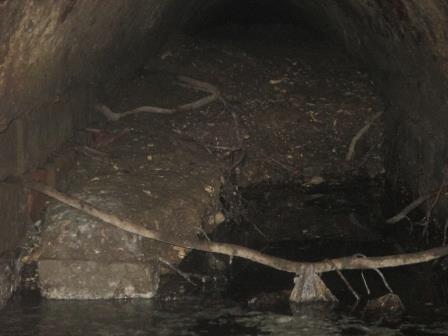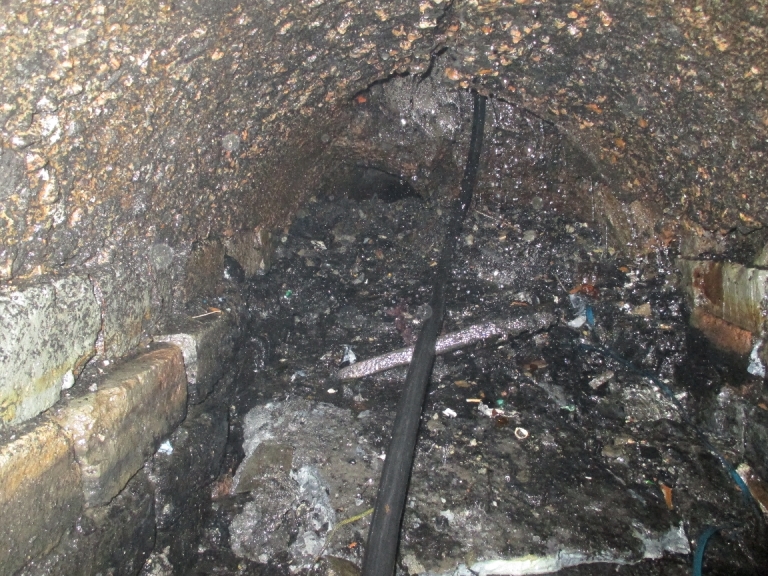An Guanfeng, chief engineer of Guangzhou Municipal Group, was searching for an effective solution to rehabilitate a 200-ft (61-m) stretch of an arch tunnel on a stormwater collection tunnel in the old town section of Guangzhou. The city, formerly known as Canton, is the capital of Guangdong Province in the People’s Republic of China.

Root intrusion and corrosion had caused severe damage to the brick-and-masonry structure, which is more than a century old. The city’s Pearl River, just a block away, creates a high groundwater table. Its hydraulic pressure caused the weakened tunnel to collapse, resulting in severe leaking. Heavy silt covered more than 30% of the pipeline’s bottom.

The city was seeking a structural rehabilitation and infiltration control solution with a 50-year service life. The tunnel’s irregular shape, 31.5-in (800-mm) wide at the bottom with an 800-mm diameter rounded top, created an unusual design challenge. Less than 3 ft (0.9 m) in diameter, the tunnel constituted a relatively small size line to accommodate human entry, which would be necessary for the rehabilitation process. Guanfeng compared four possible rehabilitation methods and chose SprayWall†, a spray-applied liner from Sprayroq, Inc. (Pelham, Alabama), to hold up against the river’s hydraulic pressure because of its durability, waterproofing, and structural characteristics.
Guanfeng had first been introduced to this protective and structural coating at a pipeline industry conference in Xiamen, China in 2011. At the conference, Xiamen Anyue Trenchless Technology Engineering, Ltd. performed an onsite demonstration of the spray-applied lining process to the conference attendees. Guanfeng was impressed by the demonstration, and began spending considerable time learning about both the protective and structural properties of the material, the application process, and the expected service life. He believed this trenchless rehabilitation project would be an ideal opportunity to demonstrate the efficacy of this spray-lining technology to the city’s utility departments.
Guangzhou Municipal Group contracted Xiamen Anyue as the project’s general contractor. The company would be responsible for inspection, cleaning, and rehabilitation of the tunnel, and provided on-site consultation on specific technology, installation, and design issues.
Confined Space Inspection and Cleaning
The tunnel was inspected and cleaned by a five-man crew, including a supervisor. A city representative was also on hand to observe the rehabilitation process. The line was inspected using the QuickView† manhole and pipeline survey system, which allows a single-operator survey from street level. The survey system does not use closed-circuit TV, which made it ideal for entering the small tunnel. The survey process took about three hours.
Once the inspection had determined the exact scope of work required, the cleaning process began. Since large cleaning equipment wouldn’t fit in the tunnel, hand methods were used. Power washing and mechanical brushing were alternately used to loosen debris, and 51.8 tons of silt were shoveled out by hand and transferred to a landfill. The whole cleaning process took about 10 days. This cleaning revealed some deteriorated areas in the vault, where tree roots had pushed aside the masonry sidewall. This collapsed section was removed using a hand pick and impact drill, and the rubble was removed by wheelbarrow. The masonry sidewall was rebuilt by hand using traditional masonry techniques with brick, stone, and mortar. This patch was reinforced by attaching a 4-mm thick, 8 ft2 (0.7 m2) arched stainless steel plate with expansion bolts. The entire process took about five days.
Lining Process
The entire surface was then repaired with microgrout where needed, then troweled-on concrete was applied to the surface to form an even substrate for the spray liner. The concrete was then thoroughly dried using hot air blowers, with special attention paid to the tunnel bottom. Once the surface was deemed adequately dry, the spray liner was applied. The job specification called for the spray lining be applied in sections at a thickness of 6 mm to achieve both waterproofing and structural rigidity to combat the hydraulic pressure from the high water table around the tunnel’s location near the Pearl River. Actual spray application time was one week. Cure time of the spray lining is immediate, and in most applications, the asset can be immediately returned to service.
Following cure time, the building inspector performed peel strength testing on the lining, which was determined to meet local building code #50728. For this project, it was decided to wait a day until final installation inspection because of the area’s high groundwater table. After the application’s final inspection 24 hours later, the bypassed tunnel was returned to service.

Expectations Exceeded
According to Guanfeng, city officials marveled at the unique working properties, quick set-up time, and smooth cure surface of the spray-applied lining. He expects this project will lead to many other projects for protective lining products, including applications in basements, potable and wastewater lines, other stormwater tunnels, and subway and road tunnels. “We’re even looking at it to rehabilitate bridge bases and beams,” he says.
Source: Sprayroq Protective Lining Systems, sprayroq.com. Contact: John Dickson, Sprayroq—e-mail: jdickson@sprayroq.com.
†Trade name.